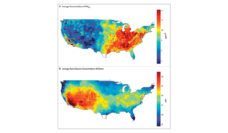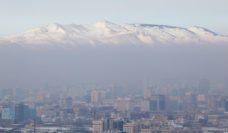A mother’s exposure to air pollution during pregnancy may affect her child’s development, increasing the risk of low birth weight and cause health complications later in the infant’s life. To examine air pollution’s impact on low birth weight among infants born in California, Dr. Olivier Laurent and colleagues conducted a seven-year case-cohort study to measure pregnant women’s exposure to different types of pollution.
Air pollution is linked to a variety of poor health outcomes, such as respiratory infections, cardiovascular disease, asthma, and lung cancer. It is also linked to premature death. Twelve thousand lives could be saved in the United States annually if fine particle pollution was reduced by a mere microgram per cubic meter. California experiences some of the worst exposure to pollution across the US, according to a 2017 State of the Air report, based on measurements of ozone and particle pollution. Most common forms of fine particle pollution in California come from wood smoke, meat cooking, and mobile emissions, which are primary contributors to secondary organic aerosols, and ozone pollution. Laurent’s research team set out to measure how different concentrations and types of pollution impact low birth weight across the state.
The research team identified every birth record between 2001 and 2008, and analyzed over 3.5 million birth records of infants carried to term (born after 37 weeks). Of these, 72,000 infants weighed less than 5 lbs. 8 ounces at birth, the low birthweight threshold. Each maternal household was geo-located and controls were randomly selected from the source population. The research team collected information on the different types and sources of pollution around the state and maternal residences using four different types of modeling and measuring techniques. They collected data from air monitoring stations and calculated the composition of particulate matter, local traffic emissions, and local traffic distance and density from maternal households.
Another source of pollution found to be significantly associated was particulate matter from commercial meat cooking, such as from charbroiling hamburgers.
Ozone and very fine secondary organic aerosol particles were two types of pollution found to have the strongest, significant association with low birth weight. Pollution sources, such as gasoline and diesel exhaust particles from automobiles were positively and significantly associated with lower birth weights. Another source of pollution found to be significantly associated was particulate matter from commercial meat cooking, such as from charbroiling hamburgers.
Maternal home distance from major roadways was associated with higher odds of low birth weight among infants; significantly impacting infant weight at distances of 100 meters or less. African Americans infants were found to be three times more likely than Caucasian infants to be born underweight, followed by Asian and Hispanic infants.
Ozone exposure was found to be most associated with low birth weight during all three trimesters of pregnancy. Secondary organic aerosols were most significantly and positively associated with low birth weight during the second trimester, whereas pollution from gasoline exhaust and commercial meat cooking were most hazardous during the third trimester of pregnancy.
Clean air policies have helped to reduce air pollution levels across California. Eight cities, including Los Angeles and Sacramento, have experienced their lowest recording of ozone averages yet. With the Environmental Protection Agency rolling back Clean Air Act regulations, cities and states will be responsible for implementing and enforcing clean air policies.
Feature image: MichaelBlackburn/iStock













